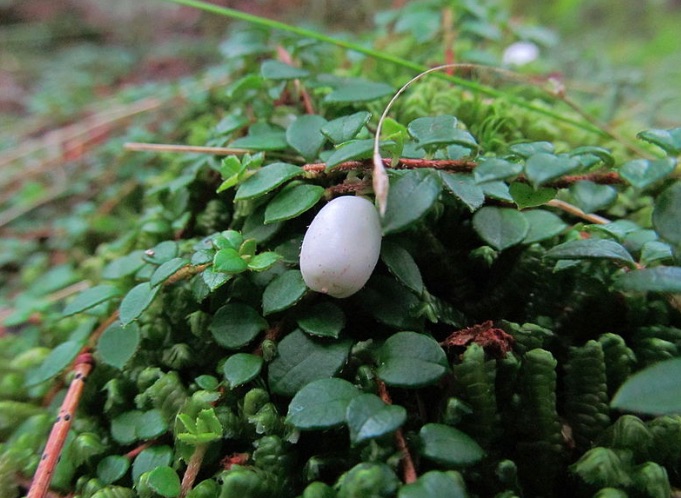Quick links
maidenhair
DCHP-2 (Mar 2014)
Spelling variants:maiden hair, Maiden Hair, Maidenhair, magna-tea, maidner tea, manna-tea
n. — Newfoundland, Flora
either of two species of evergreen shrub, Gaultheria hispidula (see Image 1) or Gaultheria procumbens; the fruit of these plants.
Type: 2. Preservation — In Newfoundland, maidenhair is the name for two species of the Gaultheria plant genus, G. hispidula and G. procumbens. The term is preserved from British English, where it can refer to any of several types of creeping plants (see EDD, s.v. "maiden" (2), for a list of examples). It is also seen in the US in reference to G. hispidula (DARE, s.v. "maidenhair-berry"), though the name is more common with a series of ferns (DAE, s.v. "Maidenhair"). More popular names in the US for G. hispidula are creeping snowberry or moxie plum, which match the plant somewhat better than the Newfoundland term (see Image 1). It is unclear whether the vastly different Newfoundland spelling variants, such as magnatea or manna-tea, derive from maidenhair or from manna, of biblical origins, which has been applied to a number of plants (see the 1987 quotation).
See also OED-3, s.v. "maidenhair" (3.d), which is marked "regional (chiefly Newfoundland)".
See also OED-3, s.v. "maidenhair" (3.d), which is marked "regional (chiefly Newfoundland)".
See: teaberry
Quotations
1765
In most parts of the island the Sarsaparilla Root is in great abundance, and very good. The Mountain Shrub and Maiden Hair are also pretty common, of whose leaves and berries the Acadian settlers frequently make a kind of tea.
1819
The snake-root, the capilaire, or maidenhair, and the wisha capucoa, well known in most parts of the north of America, under the name of American, or Indian tea, are likewise extremely common in Newfoundland and the neighbouring islands.
1858
We picked up some of the floating sea weed around us which is very curious in its construction, it greatly resembles what we usually call in Nova Scotia Maidenhair, it bears small berries in the same manner, and they are supposed to contain small worms inside, but too small to be discerned by the naked eye.
1906
Through an other gate we pass into a grove, but one quite different from the first. Instead of spruce trees, others of not so formidable aspect strike our view; our path soft and velvety, consists of moss and trailing maidenhair with purple violets, white stars and tiny pink bells strewn in fragrance all around.
1938
One other berry must not be forgotten, though there are many, including the squash berry, which claim mention for their value to a settlement deprived of larger fruits, and this is the capillaire or maidenhair berry; often called Maiden-a-tea, because it is said that from the leaves of this berry the Micmacs and the early settlers made a tea.
1952
The floor of the forest was carpeted in the damp spots with spongy moss studded by dog's puddin's, ferns, and pitcher plants. This was a fine place to pick dewberries and maidenhair berries. The tiny maidenhair leaves reeved off in the teeth tasted almost as good as the berry itself.
1978
My grandmother used to get the maiden hair berries in the summer, steep them out, add molasses and put the wine in bottles. If your chest got clogged, she'd give you a little nitch to clear you up.
1987
Magnatea Berry, Maidenhair, and Manna-tea Berry - Gaultheria hispidula (L.) Bigel, [Creeping Snowberry]. In England 'Maidenhair' has been used for several creeping plants with fine or small leaves[...]. The other two Newfoundland common names could be derived from 'Maidenhair' or they could be based on 'manna', which with various meanings has been applied to plants (OED).
1994
One plant, "maidenhair" (almost certainly Gaultheria hispidula, see creeping snowberry), was noted in an eighteenth-century account of Newfoundland as an abortifacient.
2005
All summer and into the fall he picked wild berries -- bakeapples, raspberries, whorts, partridgeberries, and marsh berries -- and offered them from door to door for whatever price he could get. And once he even tackled the maidenhair berries -- a hopeless task because they were tiny and scarce and turned to a milky fluid in his bucket -- because he heard they brought a dollar a gallon.
References
- OED-3 • "maidenhair"
- EDD
- DARE
- DAE
Images
